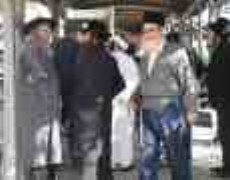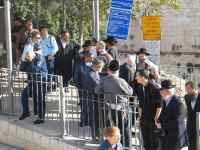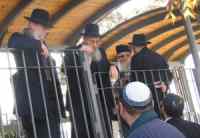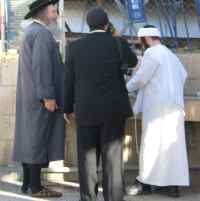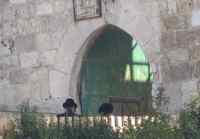Hachrazah 5765 Kislev 26
Informal translation from Hebrew of the 26 Kislev, 5765 (9 December 2004) statement:
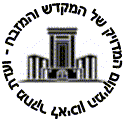
Committee for the exact site of the Holy Temple and Altar
Secretary: Rabbi Amnon Hever Tel: 054-9400909 b.d.hartzion@gmail.com
Members of the Sanhedrin ascend to the Temple Mount
In a dramatic but unpublicized move Monday, members of the newly established Sanhedrin ascended the Temple Mount, Judaism's holiest site.[1]
Close to fifty recently ordained "samuchim," members of the Sanhedrin, lined up at the foot of the Temple Mount Monday morning. The men, many ascending the Temple Mount for the first time, had immersed in mikvaot[2] that morning and planned to ascend as a group. Despite prior approval from the Israeli police who oversee entry to the Mount, the officers barred the group from entering the Mount together, saying they could only ascend in groups of ten.
Many of the samuchim refused to ascend under the restrictive conditions, especially as a group of over 100 gentile tourists filed past the waiting rabbis and up onto the holy site. "It is unconscionable that on the eve of Chanukah, which celebrates the rededication of the Holy Temple, we should once again be barred from worshipping - by our own people," Rabbi Chaim Richman of Jerusalem's Temple Institute told IsraelNN's Ezra HaLevi.
The Sanhedrin, a religious assembly of 71 sages that sat from the time of the Holy Temple through 425 CE, was the highest Jewish legal-judicial tribunal in the Land of Israel. The great court used to convene in one of the Temple's chambers in Jerusalem. On October 14, the Sanhedrin was reestablished for the first time in 1,600 years, at the site of its last meeting in Tiberius.
"There is a special mitzvah, not connected to time, but tied to our presence in Israel, to establish a Sanhedrin," Rabbi Meir HaLevi (no relation), one of the 71 members of the new Sanhedrin, told Israel National Radio's Weekend Edition. "The Rambam[3] describes the process exactly in the Mishna Torah[4]. When he wrote it there was no Sanhedrin, and he therefore outlines the steps necessary to establish one. When there is a majority of rabbis, in Israel, who authorize one person to be a Ôsamuch,' an authority, he can then reestablish the Sanhedrin."
Those behind the revival of the Sanhedrin stress that the revival of the legal body is not optional, but mandated by the Torah. "We don't have a choice," says Rabbi Richman, "it is a religious mandate for us to establish a Sanhedrin."
The Sanhedrin was reestablished through the ordination of a rabbi agreed-upon by the majority of prominent rabbis in Israel and approved as "fitting to serve" by former Chief Sefardi Rabbi Ovadia Yosef and leading Ashkenazi Rabbi Shalom Elyashiv. That rabbi, who is then considered to have received authentic ordination as handed down from Moses, was then able to give ordination to 70 others, making up the quorum of 71 necessary for the Sanhedrin.
"Even Mordechai HaYehudi, from the Purim story, was only accepted, as it is written, Ôby the majority of his brethren,' not by everybody, because anyone who deals with public issues can not be unanimously accepted," HaLevi explained.
The rabbis behind the Sanhedrin's reconstitution claim that, like the State of Israel, the old-new Sanhedrin is a work-in-progress. They see it as a vessel that, once established, will reach the stature and authority that it once had.
"The first members requested that their names not be published, so as to allow it to grow without public criticism of individuals," HaLevi said. "We want to give it time to develop and strengthen the institution, giving a chance for more rabbis to join." He added that each of the current members of the Sanhedrin has agreed to be a conditional member until a more knowledgeable rabbi joins, taking his place.
Rabbi Richman, also a member of the Sanhedrin, hopes the body will bring about a revolution in Jewish jurisprudence. Declining to discuss exactly what issues are on the Sanhedrin's agenda, Richman said that one of the main long-term goals of the Sanhedrin, which includes members of Ashkenazi, Sefardi, Hasidic, National-Religious and Haredi communities, is to reunify Jewish observance in Israel.
"We Jews went into exiles all over the world," HaLevi told INR's Weekend Edition. "Every community established its own court. We are talking about more than 50 different legal systems developing apart from one another. Part of our return to Israel is the reunification of our Jewish practices."
There is a tradition[5] that the Sanhedrin will be restored after a partial ingathering of the Jewish exiles, but before Jerusalem is completely rebuilt and restored. There is also a Talmudic tradition [6] that Elijah the Prophet will present himself before a duly-ordained Sanhedrin when he announces the coming of the Messiah, meaning that - despite common misconceptions - a Sanhedrin is a pre-, not post-messianic institution.
Click here to see the Hebrew version
References
- ↑ From Arutz Sheva News, December 14, 2004: “Newly Formed Sanhedrin Ascend to Temple Mount”
- ↑ ritual baths
- ↑ 12th century Torah scholar Maimonides
- ↑ his seminal work codifying Jewish Law
- ↑ Tractate Megillah 17b, Rashi
- ↑ Eruvin 43b; Maharatz Chajas ad loc; Rashash, Sanhedrin 13b
This ruling in the news
- Reclaiming Judaism's holiest place Haaretz, June 09, 2009 Sivan 17, 5769
- Rabbi Moshe Tendler Visits Temple Mount The Yeshiva World News, July 9, 2008 (Ed. Note: Rabbi Tendler is not associated with the nascent Sanhedrin)
